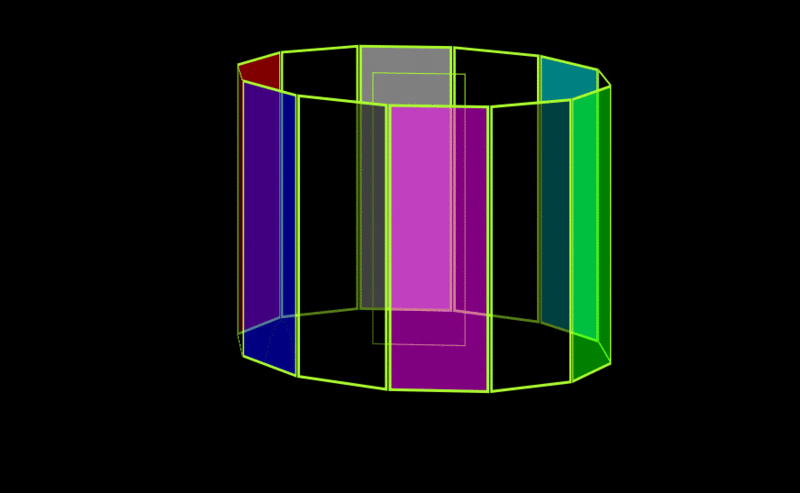Exemple d'animation CSS3D+ (code complet ci-joint)
Cet article vous apporte des exemples d'animation CSS3D+ (code complet ci-joint). Il a une certaine valeur de référence. Les amis dans le besoin peuvent s'y référer.
Avant-propos
J'ai récemment joué avec l'utilisation de CSS pour créer des effets 3D et j'ai écrit plusieurs démos, je vais donc les résumer dans ce blog. Avant de lire ce blog, veuillez d'abord comprendre les propriétés du CSS 3D, telles que : transform-style, transform-origin, transform, perspective.
Écrivez un cube simple
1. Nous utilisons d'abord du CSS pour implémenter un cuboïde. Un cuboïde a 6 côtés et nous l'enveloppons avec un ul selon My. l'expérience dans l'écriture d'animation 3D est qu'il est préférable d'avoir un élément parent à envelopper
<p> </p>
- 1
- 2
- 3
- 4
- 5
- 6
2. Définissez d'abord la largeur et la hauteur de .parent, puis définissez la distance de visualisation et position du point de base pour celui-ci.
.parent{
width: 800px;
height: 400px;
border: 1px solid #000;
margin: 0 auto;
perspective: 2000px;
perspective-origin: -40% -80%;
background: #000;
}3. Définissez les attributs de largeur, de hauteur et de préservation-3d de ul pour conserver la transformation 3D des sous-éléments, et tous les sous-éléments li sont positionnés de manière absolue
ul{
width: 50px;
position: relative;
margin: 100px auto;
transform-style : preserve-3d;
}
li{
width: 100px;
height: 100px;
background: rgba(255, 255, 0, 0.3);
position: absolute;
text-align: center;
border: 3px solid greenyellow;
}L'effet est comme indiqué ci-dessous :

4. background pour son arrière-plan : rgba(255, 255, 0, 0.3);
li:nth-child(1){
background: rgba(255, 255, 0, 0.3);
transform: translateY(50px) rotateX(90deg);
}L'effet est comme indiqué ci-dessous :

5. Nous avons écrit le premier visage, puis nous ajustons les 6 autres visages pour qu'ils deviennent comme indiqué dans l'image ci-dessous. Le sens de rotation ne sera pas expliqué ici. Les amis qui ne comprennent pas peuvent vérifier eux-mêmes d'autres documents.
/*上面*/
li:nth-child(1){
transform: translateY(-50px) rotateX(90deg);
}
/*下面*/
li:nth-child(2){
transform: translateY(50px) rotateX(90deg);
}
/*左面*/
li:nth-child(3){
transform: translateX(-50px) rotateY(90deg);
}
/*右面*/
li:nth-child(4){
transform: translateX(50px) rotateY(90deg);
}
/*前面*/
li:nth-child(5){
transform: translateZ(50px);
}
/*后面*/
li:nth-child(6){
transform: translateZ(-50px);
}L'effet est le suivant :

Voici les effets de deux animations CSS3D+
1. Le code est le suivant :
nbsp;html>
<meta>
<meta>
<meta>
<title>书页2</title>
<style>
.container{
width: 1000px;
height: 650px;
background: #000;
perspective: 2000px;
border: 1px solid transparent;
overflow: hidden;
margin: 0 auto;
perspective-origin: 10% 20%;
}
.cube{
width: 200px;
height: 300px;
transform-style: preserve-3d;
margin:100px auto;
position: relative;
transform: rotateX(30deg);
border-radius: 50%;
padding: 60px;
}
.mian{
width: 200px;
height: 300px;
background-image: url(1.jpg);
background-position:400px 0;
position: absolute;
border: 1px solid #ccc;
transition: 2s;
}
/* .mian1:hover{
transform-origin: right;
transform: rotateY(-60deg);
} */
.mian1{
transform-origin: right;
transform: translateX(-200px) rotateY(45deg);
background-position: 0 0;
}
.mian3{
transform-origin: left;
transform: translateX(200px) rotateY(45deg);
background-position: 200px 0;
}
.mian3:hover{
transform: translateX(200px) rotateY(0deg);
}
.mian1:hover{
transform: translateX(-200px) rotateY(0deg);
}
</style>
<p>
</p><p>
</p><p></p>
<p></p>
<p></p>
2. >L'effet est le suivant :
nbsp;html>
<meta>
<meta>
<meta>
<title>立方体</title>
<style>
*{
margin: 0;
padding: 0;
list-style: none;
}
.parent{
width: 1000px;
margin: 0 auto;
height: 600px;
background: black;
perspective: 5000px;
perspective-origin: -40% -120%;
border: 1px solid #000;
}
ul{
width: 100px;
height: 300px;
position: relative;
margin:100px auto;
transform-style: preserve-3d;
animation: zuan 3s linear infinite;
border: 1px solid greenyellow;
}
li{
width: 100px;
height: 300px;
background: rgba(0, 0, 0, 0.5);
position: absolute;
text-align: center;
line-height: 100px;
border: 3px solid greenyellow;
}
li:nth-child(1){
transform: rotateY(30deg) translateZ(-200px);
}
li:nth-child(2){
transform: rotateY(60deg) translateZ(-200px);
background: rgba(255, 0, 0, 0.5);
}
li:nth-child(3){
transform: rotateY(90deg) translateZ(-200px);
}
li:nth-child(4){
transform: rotateY(120deg) translateZ(-200px);
background: rgba(0, 0, 255, 0.5);
}
li:nth-child(5){
transform: rotateY(150deg) translateZ(-200px);
}
li:nth-child(6){
transform: rotateY(180deg) translateZ(-200px);
background: rgba(255, 0, 255, 0.5);
}
li:nth-child(7){
transform: rotateY(210deg) translateZ(-200px);
}
li:nth-child(8){
transform: rotateY(240deg) translateZ(-200px);
background: rgba(0, 255, 0, 0.5);
}
li:nth-child(9){
transform: rotateY(270deg) translateZ(-200px);
}
li:nth-child(10){
transform: rotateY(300deg) translateZ(-200px);
background: rgba(0, 255, 255, 0.5);
}
li:nth-child(11){
transform: rotateY(330deg) translateZ(-200px);
}
li:nth-child(12){
transform: rotateY(360deg) translateZ(-200px);
background: rgba(255, 255, 255, 0.5);
}
@keyframes zuan{
0%{
transform: rotateY(0deg);
}
100%{
transform: rotateY(360deg);
}
}
</style>
<p>
</p> Recommandations associées :
Recommandations associées :
Comment utiliser du CSS pur pour implémenter un petit moine souriant et méditant
Comment implémenter des effets d'ombre de police en utilisant CSS attributs ? (Démo de code)
Ce qui précède est le contenu détaillé de. pour plus d'informations, suivez d'autres articles connexes sur le site Web de PHP en chinois!

Outils d'IA chauds

Undresser.AI Undress
Application basée sur l'IA pour créer des photos de nu réalistes

AI Clothes Remover
Outil d'IA en ligne pour supprimer les vêtements des photos.

Undress AI Tool
Images de déshabillage gratuites

Clothoff.io
Dissolvant de vêtements AI

Video Face Swap
Échangez les visages dans n'importe quelle vidéo sans effort grâce à notre outil d'échange de visage AI entièrement gratuit !

Article chaud

Outils chauds

Bloc-notes++7.3.1
Éditeur de code facile à utiliser et gratuit

SublimeText3 version chinoise
Version chinoise, très simple à utiliser

Envoyer Studio 13.0.1
Puissant environnement de développement intégré PHP

Dreamweaver CS6
Outils de développement Web visuel

SublimeText3 version Mac
Logiciel d'édition de code au niveau de Dieu (SublimeText3)

Sujets chauds
 1393
1393
 52
52
 1206
1206
 24
24
 Comment utiliser Bootstrap en Vue
Apr 07, 2025 pm 11:33 PM
Comment utiliser Bootstrap en Vue
Apr 07, 2025 pm 11:33 PM
L'utilisation de bootstrap dans vue.js est divisée en cinq étapes: installer bootstrap. Importer un bootstrap dans main.js. Utilisez le composant bootstrap directement dans le modèle. Facultatif: style personnalisé. Facultatif: utilisez des plug-ins.
 Les rôles de HTML, CSS et JavaScript: responsabilités de base
Apr 08, 2025 pm 07:05 PM
Les rôles de HTML, CSS et JavaScript: responsabilités de base
Apr 08, 2025 pm 07:05 PM
HTML définit la structure Web, CSS est responsable du style et de la mise en page, et JavaScript donne une interaction dynamique. Les trois exercent leurs fonctions dans le développement Web et construisent conjointement un site Web coloré.
 Comment écrire des lignes fendues sur bootstrap
Apr 07, 2025 pm 03:12 PM
Comment écrire des lignes fendues sur bootstrap
Apr 07, 2025 pm 03:12 PM
Il existe deux façons de créer une ligne divisée bootstrap: en utilisant la balise, qui crée une ligne divisée horizontale. Utilisez la propriété CSS Border pour créer des lignes de fractionnement de style personnalisées.
 Comprendre HTML, CSS et JavaScript: un guide pour débutant
Apr 12, 2025 am 12:02 AM
Comprendre HTML, CSS et JavaScript: un guide pour débutant
Apr 12, 2025 am 12:02 AM
WebDevelopmentReliesOnHTML, CSS, etjavascript: 1) HTMLSTRUCTURESCONTENT, 2) CSSSTYLESIT, et3) JavascriptAdddsInterActivity, Forming TheasisofmodernweBEBExperiences.
 Comment configurer le cadre de bootstrap
Apr 07, 2025 pm 03:27 PM
Comment configurer le cadre de bootstrap
Apr 07, 2025 pm 03:27 PM
Pour configurer le framework Bootstrap, vous devez suivre ces étapes: 1. Référez le fichier bootstrap via CDN; 2. Téléchargez et hébergez le fichier sur votre propre serveur; 3. Incluez le fichier bootstrap dans HTML; 4. Compiler les sass / moins au besoin; 5. Importer un fichier personnalisé (facultatif). Une fois la configuration terminée, vous pouvez utiliser les systèmes, composants et styles de grille de Bootstrap pour créer des sites Web et des applications réactifs.
 Comment utiliser le bouton bootstrap
Apr 07, 2025 pm 03:09 PM
Comment utiliser le bouton bootstrap
Apr 07, 2025 pm 03:09 PM
Comment utiliser le bouton bootstrap? Introduisez Bootstrap CSS pour créer des éléments de bouton et ajoutez la classe de bouton bootstrap pour ajouter du texte du bouton
 Comment redimensionner le bootstrap
Apr 07, 2025 pm 03:18 PM
Comment redimensionner le bootstrap
Apr 07, 2025 pm 03:18 PM
Pour ajuster la taille des éléments dans Bootstrap, vous pouvez utiliser la classe de dimension, qui comprend: ajuster la largeur: .col-, .w-, .mw-ajustement Hauteur: .h-, .min-h-, .max-h-
 Comment insérer des photos sur bootstrap
Apr 07, 2025 pm 03:30 PM
Comment insérer des photos sur bootstrap
Apr 07, 2025 pm 03:30 PM
Il existe plusieurs façons d'insérer des images dans Bootstrap: insérer directement les images, en utilisant la balise HTML IMG. Avec le composant d'image bootstrap, vous pouvez fournir des images réactives et plus de styles. Définissez la taille de l'image, utilisez la classe IMG-FLUID pour rendre l'image adaptable. Réglez la bordure en utilisant la classe IMG-border. Réglez les coins arrondis et utilisez la classe Roundée IMG. Réglez l'ombre, utilisez la classe Shadow. Redimensionner et positionner l'image, en utilisant le style CSS. À l'aide de l'image d'arrière-plan, utilisez la propriété CSS d'image d'arrière-plan.




